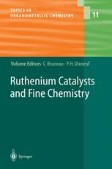Search
Search Results
-
Carbene Complexes of Heme Proteins and Iron Porphyrin Models
The possible formation of carbene complexes of cytochromes P450 enzymes in various metabolisms of xenobiotics is first described. In view of these...
-
Ferrocene–Peptide Bioconjugates
This chapter sketches an outline of ferrocene–peptide bioconjugates. A variety of ferrocene–peptide bioconjugates have been designed to induce...
-
Catalytic Nickel–Iron–Sulfur Clusters: From Minerals to Enzymes
The geochemical theory of the origin of life proposes that primordial, pre-biotic reactions were carried out in a metal-sulfide-rich environment...
-
Sequentially Palladium-Catalyzed Processes
Sequentially palladium-catalyzed reactions consist of combinations of identical, related, or significantly different palladium-catalyzed processes...
-
n-Body Decomposition Approach to the Calculation of Interaction Energies of Water Clusters
A new methodology is proposed in which large basis set MP2-level calculations can be extended to water clusters with as many as 50 monomers. The...
-
Intermolecular Interactions via Perturbation Theory: From Diatoms to Biomolecules
This article is devoted to the most recent, i.e. taking place within the last few years, theoretical developments in the field of intermolecular...
-
Computer-Aided Conformation-Dependent Design of Copolymer Sequences
A survey is given of the simulation methods as applied to the design of nontrivial sequences in synthetic copolymers aimed at achieving desired...
-
After-Action of the Ideas of I.M. Lifshitz in Polymer and Biopolymer Physics
We review the development of ideas in polymer physics initially formulated by I.M. Lifshitz. We start with general issues in polymer statistics,...
-
Role of Physical Factors in the Process of Obtaining Copolymers
A brief introduction into the principles of the statistical description of the chemical structure of linear heteropolymers is given....
-
Tin-Free Radical Reactions Mediated by Organoboron Compounds
The development of tin-free methods to run radical reactions is crucial for their applications in industrial processes as well as in drug...
-
The Degenerative Radical Transfer of Xanthates and Related Derivatives: An Unusually Powerful Tool for the Creation of Carbon–Carbon Bonds
This review summarises recent work on the dithiocarbonyl group transfer reaction. Xanthates, in particular, have proved to be extremely useful for...
-
Arylation Reactions via C-H Bond Cleavage
Various carbon nucleophiles having acidic C–H bonds, including active methylene compounds, ketones, aldehydes, esters, and so on, are arylated with...
-
Chiral Diaminocarbene Complexes, Synthesis and Application in Asymmetric Catalysis
The synthetic routes to optically pure N-heterocyclic carbene (NHC) complexes and their application in asymmetric catalysis is reviewed. Chiral...
-
Non-covalent Immobilization of Catalysts Based on Chiral Diazaligands
The immobilization of chiral catalysts through non-covalent methods, as opposed to covalent immobilization, allows an easier preparation of chiral...
-
Oxide- and Zeolite-supported “Molecular” Metal Clusters: Synthesis, Structure, Bonding, and Catalytic Properties
This review is a summary of supported metal clusters with nearly molecular properties. These clusters are formed by adsorption or surface-mediated...
-
Spectroscopic Characterization of Organometallic Centers on Insulator Single Crystal Surfaces:From Metal Carbonyls to Ziegler--Natta Catalysts
A detailed knowledge of the microscopic properties is one of the prerequisites for an understanding of heterogeneous catalysts. A strategy which...
-
Survey of Enzymological Data on ODCase
OMP decarboxylase (ODCase) has been the subject of enzymological, structural, and theoretical studies for several decades, yet its highly proficient...
-
Ruthenium-Catalyzed C–C Bond Formation
Molecular ruthenium catalysts are now currently used to perform selective carbon–carbon bond formation by combination of simple substrates. Their...
-
Cycloaddition Reactions of Group 6 Fischer Carbene Complexes
Group 6 heteroatom-stabilised carbene complexes (Fischer carbene complexes) offer many interesting possibilities to build rings (carbocycles and...
-
Photoinduced Reactions of Metal Carbenes in Organic Synthesis
The photoinduced reactions of metal carbene complexes, particularly Group 6 Fischer carbenes, are comprehensively presented in this chapter with a...
